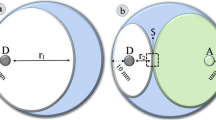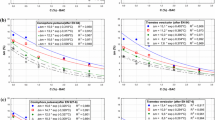Abstract
Laboratory decay tests using brown, white and soft rot fungi on wood treated with a series of dialkyldimethylammonium halides show that maximum fungitoxicity is exhibited by compounds with alkyl chains of 10 and 12 carbon atoms. Both the cation and the anion appear to influence effectiveness with bromide salts showing greater activity values than chloride analogs. The anion presumably influences effectiveness through distribution, fixation, and availability of the compounds rather than directly by changes in fungitoxicity. Monobromination of one of the alkyl chains caused a decrease in fungitoxicity, though the alkyl chain length-fungitoxicity relationship was the same as for the unsubstituted series of compounds. Addition of certain copper or organic biocides to alkylammonium compound formulations increased activity, particularly against soft rot. While this result is a significant advance, the complex relationships involved in such formulations will demand considerable further research in respect of efficacy, fixation, leaching, treatability, and environmental aspects before such a product could be commercialized.
Similar content being viewed by others
References
Nicholas, D.D., For. Prod. J. 31:28 (1981).
Cockroft, R., Int. Res. Group Wood Preser., Document No. IRG/WP/387 (1980).
Preston, A.F., unpublished.
Nicholas, D.D., and A.F. Preston, Proc. Am. Wood Preserv. Assoc. 76:13 (1980).
Butcher, J.A., A.F. Preston, M.E. Hedley, and D.J. Cross, Proc. N.Z. Wood Preser. Assoc. 17:19 (1977).
Butcher, J.A., Int. Res. Group Wood Preser., Document No. IRG/WP/3144 (1980).
Preston, A.F., and D.D. Nicholas, Wood Fiber, 14:37–42 (1982).
Hedley, M.E., K. Tsunoda and K. Nishimoto, Wood Res. 68:37(1982).
Tillot, R.J., and C.R. Coggins, Rec. Brit. Wood Preser. Assoc. Ann. Conv., 32-46(1981).
Ruddick, J.N.R., Int. Res. Group Wood Preser., Document No. IRG/WP/2152 (1981).
Butcher, J.A., and H. Greaves, Ibid., Document No. IRG/WP/ 3188 (1982).
Butcher, J.A., Mat. u. Org. 14:43 (1979).
Preston, A.F., and C.M. Chittenden, N.Z. J. For. Sci., 12, in press (1982).
New Zealand Timber Preservation Authority Specifications, C6, C7, C8, C10 (1979).
Butcher, J.A., A.F. Preston and J. Drysdale, For. Prod. J., 27:19(1977).
Preston, A.F., and J.A. Butcher, N.Z. J. For. Sci.,8:392 (1978).
Butcher, J.A., and A.F. Preston, Ibid., 8:397 (1978).
Butcher J.A., A.F. Preston and J. Drysdale, Ibid., 9:348 (1979).
Hulme, M.A., and J.F. Thomas, For. Prod. J., 29:26(1979).
Bergervoet, A.J., N.Z. Forest Service, F.R.I., For. Prod. Div. Rep. No. FP/WP 57 (1980).
Ditoro, R.D., Soap Chem. Spec. 45:47 (1969).
Dadekian, Z.A., U.S. Patent 3,836,669 (1974).
Angele, M.H., Seifen, Ole, Fette, Wachse, 10:273 (1975).
Author information
Authors and Affiliations
About this article
Cite this article
Preston, A.F. Dialkyldimethylammonium halides as wood preservatives. J Am Oil Chem Soc 60, 567–570 (1983). https://doi.org/10.1007/BF02679788
Issue Date:
DOI: https://doi.org/10.1007/BF02679788




